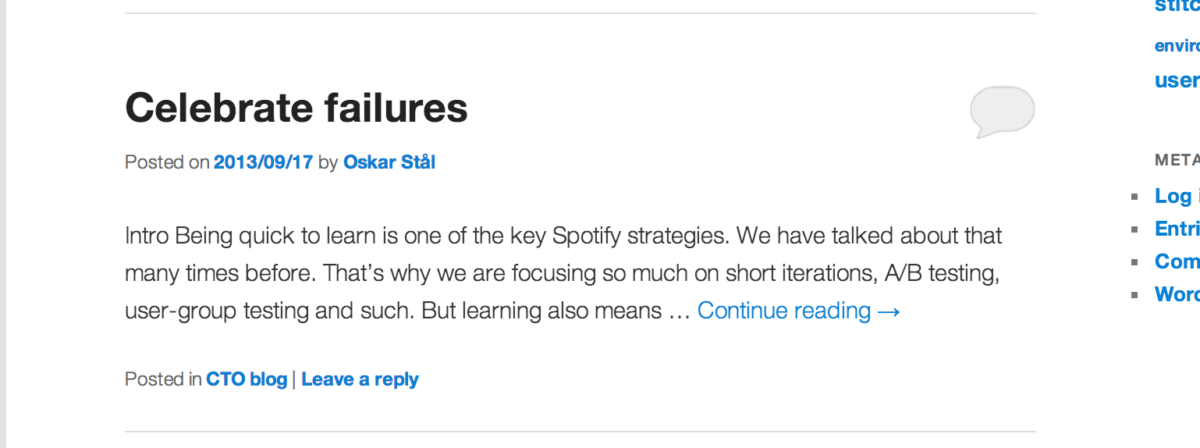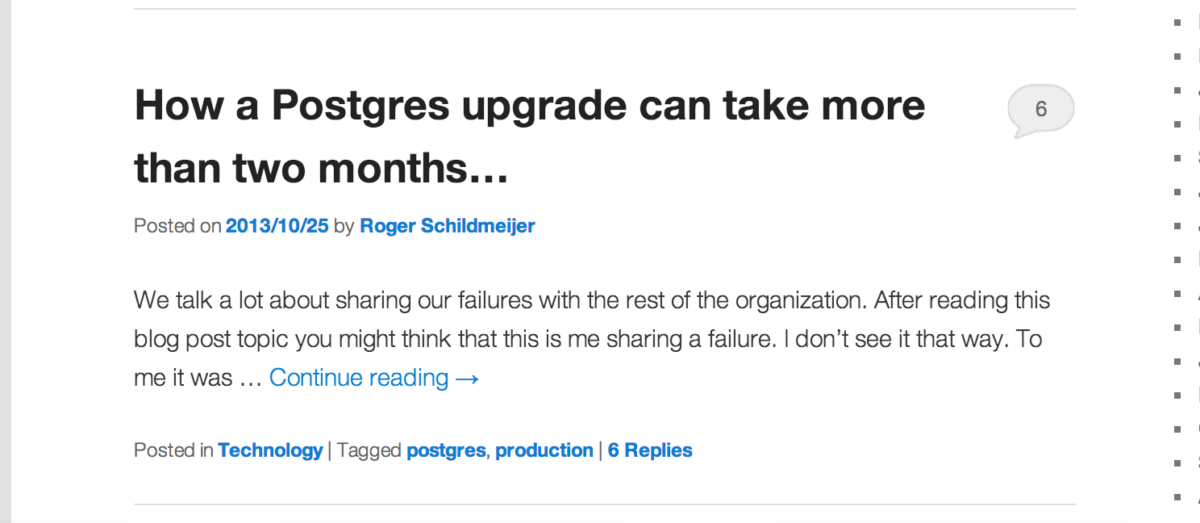Fail Safe, Fail Smart, Succeed!
- Part One: Why Focus on Failure?
- Part Two: Building a Fail-Safe Culture
- Part Three: Making Failure Safer
- Part Four: My Biggest Failure
- Part Five: Putting it into Practice
Building a fail-safe culture
If innovation requires failure, to build an innovative product or company, how your culture handles the inevitable failures is key to creating a fail-safe environment.
Many companies still punish projects or features that do not succeed. The same companies then wonder why their employees are so risk-averse. Punishing failure can take many forms, both obvious and subtle. Punishment can mean firing the team or leader who created an unsuccessful release or project. Sanctions are often more subtle:
- Moving resources away from innovative efforts that don’t yield immediate successes.
- Allowing people to ridicule failed efforts.
- Continuing to invest in the slow, steady, growth projects instead of the more innovative but risky efforts. Innovator’s dilemma is just the most well-known aspect of this.
Breeding innovation out
I spend several years working at a company whose leadership was constantly extorting the employees to be more innovative and take more risks. It created ever-new processes to encourage new products to come from within the organization. It was also a company that had always grown through acquisition. Every year, it would acquire new companies. At the start of the next year’s budget process, there would inevitably be the realization that the company had now grown too large. Nearly every year, there would be a layoff.
If you are a senior leader and need to trim ten percent of your organization, where would you look? In previous years, you likely had already eliminated your lowest performers. Should you reduce the funding of the products that bring in your revenue or kill the new products that are struggling to make their first profit? The answer is clear if your bonus and salary are dependent on hitting revenue targets.
Through the culture of the company, it communicated that taking risks was detrimental to a career. So the company lost its most entrepreneurial employees either through voluntary or involuntary attrition. Because it could not innovate within, innovation could only happen through acquisitions, perpetuating the cycle.
If failure is punished, and failure is necessary for innovation, then punishing failure, either overtly or subtly, means that you are dis-incentivizing innovation.
Don’t punish failure. Punish not learning from failure. Punish failing big when you could have failed small first. Better yet, don’t punish at all. Reward the failures that produce essential lessons for the company and that the team handles well. Reward risk-taking if you want to encourage innovation.
If you worry about employees taking risks without accountability, give them participation in the revenue that they bring in
Each failure allows you to learn many things. Take the time to learn those lessons
Learning from failure
It can be hard to learn the lessons from failure. When you fail, your instinct is to move on, to sweep it under the rug. You don’t want to wallow in your mistakes. However, if you move on too quickly, you miss the chance to gather all the lessons, which will lead to more failure instead of the success you’re seeking.
Lessons from failure: Your process
Sometimes the failure was in your process. The following exchange is fictional, but I’ve heard something very much like it more than once in my career.
“What happened with this release? Customers are complaining that it is incredibly buggy.”
“Well, the test team was working on a different project, so they jumped into this one late. We didn’t want to delay the release, so we cut the time for testing short and didn’t catch those issues. We had test automation, and it caught the issue, but there have been a lot of false positives, so no one was watching the results.”
“Did we do a beta test for this release? An employee release?”
“No.”
The above conversation indicates a problem with the software development process (and, for this specific example, a bit of a culture-of-quality problem). If you’ve ever had an exchange like the one above, what did you do to solve the underlying issues? If the answer is “not much,” you didn’t learn enough from the failure, and you likely had similar problems afterward.
Lessons from failure: your team
Sometimes your team is a significant factor in a failure. I don’t mean that the members of the group aren’t good at their jobs. Your team may be missing a skillset or have personality conflicts. Trust may be an issue within the team, and so people aren’t open with each other.
“The app is performing incredibly slowly. What is going on?”
“Well, we inherited this component that uses this data store, and no one on the team understands it. We’re learning it as we’re doing it, and it has become a performance problem.”
Suppose the above exchange happened in your team. In that case, you might make sure that the next time you decide to use (or inherit) a technology, you make sure that someone on the team knows it well, even if that means adding someone to the team.
Lessons from failure: your perception of your customers
A vein of failure, and a significant one in the lesson of Clippy, is having an incorrect mental model for your customer.
We all have myths about who our customers are. Why do I call them “myths”? The reason is that you can’t precisely read the minds of every one of your customers. At the beginning of a product’s life cycle, you may know each of your customers well when there are few of them. That condition, hopefully, will not last very long.
How do you build a model of your user? You do user research, talk to your customer service team, beta test, and read app reviews and tweets about your product. You read your product forums. You instrument your app and analyze user behavior.
We have many different ways of interacting with the subsets of our customers. Those interactions give us the feeling that we know what they want or who they are.
These interactions provide insights into your customers as an aggregate. They also fuel myths of who our customers are because they are a sampling of the whole. We can’t know all our customers, so we create personas in our minds or collectively for our team.
Suppose you have a great user research team, and you are very rigorous in your effort to understand your customers. You may be able to have in-depth knowledge about your users and their needs for your product. However, that knowledge and understanding will only be for a moment in time. Your product continues to evolve and change and hopefully add new users often. Your new customers come to your product because of the unique problems they can solve. Those problems are different from the existing users—your perception of your customers ages quickly. You are now building for who they were, not who they are.
Lessons from failure: your understanding of your product
You may think you understand your product; after all, you are the one who is building it! However, the product that your customers are using may be different from the product you are making.
You build your product to solve a problem. In your effort to solve that problem, you may also solve other problems for your customers that you didn’t anticipate. Your customers are delighted that they can solve this problem with your product. In their minds, this was a deliberate choice on your part.
Now you make a change that improves the original problem’s solution but breaks the unintended use case. Your customers are angry because you ruined their product!
Lessons from failure: yourself
Failure gives you a chance to learn more about yourself. Is there something you could do differently next time? Was there an external factor that is obvious in hindsight but could have been caught earlier if you approached things differently?
Our failures tend to be the hardest to dwell on. Our natural inclination is to find fault externally to console ourselves. It is worth taking some time to reflect on your performance. You will always find something that you can do that will help you the next time.
Collecting the lessons: Project Retrospectives
The best way that I have learned to extract the lessons is to do a project retrospective.
A project retrospective aims to understand what happened in the project from its inception to its conclusion. You are looking to understand each critical decision, what informed the decision, and its outcome.
In a project retrospective, you are looking for the things that went wrong, the things that went well, and the things that went well, but you could do better the next time. The output of the retrospective is neutral. It is not for establishing blame or awarding kudos. It exists to make sure you learn. For this reason, it is useful for both unsuccessful and highly successful projects.
A good practice for creating a great culture around failure is to make it the general custom to have a retrospective at the end of every project in your company. Having retrospectives only for the unsuccessful projects perpetuates a blame culture.
For an example of project retrospectives processes, see this post from Henrik Kniberg.
The project retrospective repository
Since the project retrospectives are blameless, it is good to share them within your company. Create a project retrospective repository and publicize it.
The repository becomes a precious resource for everyone in your company. It shows what has worked and what has been challenging in your environment. It allows your teams to avoid making the mistakes of the past. We always want to be making new mistakes, not old ones!
The repository is also handy for new employees to teach them about how projects work in your company. Finally, it is also a resource for documenting product decisions.
The retrospective repository is a valuable place to capture the history of your products and your process.
Spotify’s failure-safe culture
I learned a lot about creating a failure safe culture when I worked at Spotify. Some of the great examples of this culture were:

One of the squads created a “Fail Wall” to capture the things they were learning. The squad didn’t hide the wall. It was on a whiteboard facing the hallway where everyone could see it.

This document is a report from one of the project retrospectives. You don’t need any special software for the record. For us, it was just a collection of Google docs in a shared folder.

One of the agile coaches created a slack channel for teams to share the lessons learned from failures with the whole company.

Spotify’s CTO posted an article encouraging everyone to celebrate the lessons that they learned from failure. Which inspired other posts like this:

If you look at the Spotify engineering blog, there are probably more posts about mistakes that we made than cool things we did in the years I worked there (2013-2016).
These kinds of posts are also valuable to the community. Often, when you are searching for something, it is because you are having a problem. We might have had the same issue. These posts are also very public expressions of the company culture.
Failure as a competitive advantage

We’re all going to fail. If my company can fail smart and fast, learning from our mistakes; while your company ignores the lessons from failure, my company will have a competitive advantage.
